
Sunflower and the Birth of the Documentary Songwriting Method
An excerpt from Malcolm Brooks's 2013 Dissertation
Autoethnography of a Composer with a New Composing Method
Sunflower marks the birth of the Story-to-Song Method (now most often called the Documentary Songwriting Method) and the culmination of the first stage of evolution of a creative method. In retrospect, I am amazed at how long I had stumbled along trying to help people build songs from titles based on phrases in spoken stories. I had overlooked the stories themselves. I had been looking for a story within a title rather than a title within a story. After the completion of the song, I began to consider a new lesson: All parts of a song – melody, rhythm, chorus, verses – may lie within a spoken story.
In 2009, Hannah Batley, a local composer, and I had collaborated successfully on a choral song for the Rockland Unitarian Universalist Church, of which she was the musical director. We decided to collaborate on another piece, and Hannah showed me a melodic and lyrical idea that she had been exploring. She had written:
So hold me and sing to me songs
Of the Sunflower
With God in its seed. (Batley & Brooks, 2010)
We discussed where the song should go next. I asked her about the origins the sunflower idea. She told me about a deceased man in her community, a friend of the family, who had played a grandfatherly role for her during her childhood. As she described him through anecdotes, I heard myself saying, “Hannah, that’s the song.”
She repeated the anecdotes and, this time, I typed down every word she said. From there we began breaking the story into paragraphs and the sentences into phrases, one to a line. Her spoken words began to look like a poem in free verse.
Our session drew to a close Hannah and I reviewed what we had done. I felt that Hannah’s chorus now fit well in between the rough verses that her spoken words had provided. I also felt the desire to add three lines to the chorus with hopes that Hannah would not object. I felt that one more line might make Hannah’s message even clearer. I sang the chorus as:
So hold me and sing to me songs
Of the Sunflower
With God in its seed.
Remind me life is beautiful.
Remind me of the sunflower.
That’s all I need. (Batley & Brooks, 2010)
At our next session, Hannah and I completed the song. As I played guitar, based upon the chords she had originally written, Hannah improvisationally made up a melody to the words she had spoken, now in verse format. We were surprised and pleased with the outcome. There were more anecdotes than we needed, so Hannah chose which ones to keep.
At the time, I did not think that Hannah and I were following a method. We were merely trying to a complete a song. Yet the transition from spoken word to finished song did imply a process, even if it was an explorational one. To provide a sense of this transition from spoken word to song, I present below both the original words that Hannah spoke and the lyrics that were shaped from them.
—
While reading the history of Sunflower above, you may be interested to hear the very first sing-through that marks the birth of the documentary songwriting method. It is available below. Hannah Batley reads back her spoken words and improvises a melody. The skeleton of the final melody is evident in this first sing-through.
FOR PROSPECTIVE TEACHING ARTISTS
Individuals to Contact About DocSong Training
United Kingdom and Europe
Jonny Westhorp, Bristol, England
Europe and Middle East
Melodi Var Öngel, Adana, Turkey
Midwest & Western United States
Nora Willauer, Cleveland, Ohio
Joaquin Contreras, Houston, Texas
Mid-Atlantic & Southern United States
Khalid Taylor, Bethlehem, Pennsylvania
Mimi Bornstein, Alexandria, Virginia
Alex Wilder, Nashville, Tennessee
New England & Canada
Zach Arfa, Mystic, Connecticut
Chloë Isis, Brunswick, Maine
Malcolm Brooks, Rockport, Maine
Will Foote, Rockport, Maine
Caleb Edwards, Camden, Maine
Chris Finn, Camden, Maine
Hazel Delehey, Lewiston, Maine
Whit Arau, Somerville, Massachusetts


 "He was my adopted-by-affection grandfather in the area and my sister’s godfather officially. And he used to sing me Ukrainian lullabies in the kitchen rocking chair and he used to carve ducks out of wood. He had a wood shop and, every time I would walk in, he would kiss my hand. It got to the point where I would walk in like this. (Hannah demonstrates: Hand outstretched and waiting.)
"He was my adopted-by-affection grandfather in the area and my sister’s godfather officially. And he used to sing me Ukrainian lullabies in the kitchen rocking chair and he used to carve ducks out of wood. He had a wood shop and, every time I would walk in, he would kiss my hand. It got to the point where I would walk in like this. (Hannah demonstrates: Hand outstretched and waiting.)
